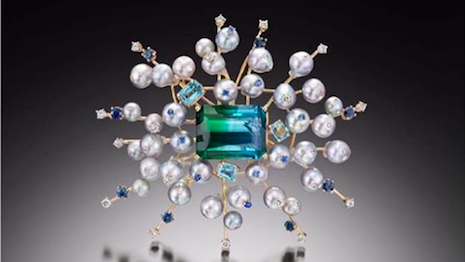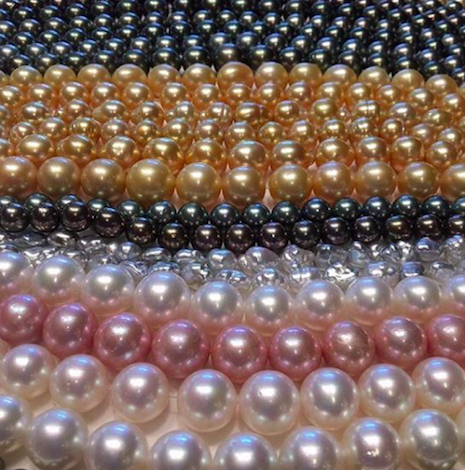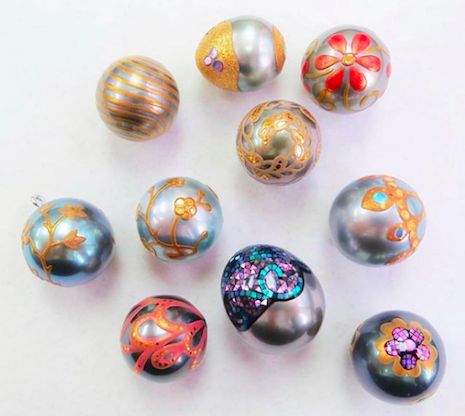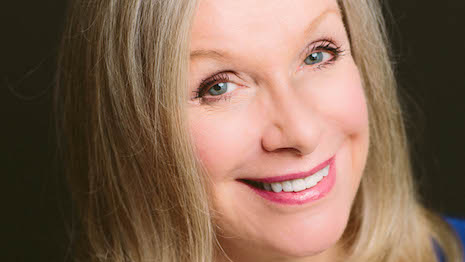- About
- Subscribe Now
- New York,
December 12, 2018

 Akoya pearl and gemstone brooch from Russell Trusso Fine Jewelry. Image credit: Cultured Pearl Association of America
Akoya pearl and gemstone brooch from Russell Trusso Fine Jewelry. Image credit: Cultured Pearl Association of America
While the jewelry industry pulls its collective hair out over mined versus man-made diamonds and millennials, it is time to change the conversation and talk about another gem perfectly suited to the next generation of luxury jewelry consumers.
Pearls are a natural, organic, environmentally sustaining and virtually renewable gem. Pearls come in all shapes and colors, play well with other gems, metals and materials, and can be quite affordable compared to gemstones. What is more millennial than that?
Prized throughout history, pearls have waxed and waned in popularity in the contemporary jewelry market, said Hedda Shupak, editor of the Centurion newsletter.
Ms. Shupak believes pearls are having a fashion moment now, but “definitely not your traditional strand or even a stud earring look.”
Millennial interest is in designs that “avoid the mother-of-the-bride look,” said Maria Then, creative director of The Product Collective serving the jewelry industry.
The natural beauty, luster and uniqueness of pearls in thoroughly modern, not-your-mothers’ style are on display in the recent winners of the Annual International Pearl Design Competition.
The winning one-of-a-kind American designs are now on a three-city road tour sponsored by The Cultured Pearl Association of America (CPAA). This is the first time that the winning designs will be available for sale at retailers.
Max’s in Minneapolis, MN, is currently hosting the display through Dec. 7, headlined by Adam Neeley’s President’s Trophy-winning Rivoli earrings that combine golden South Sea pearls and cream-to-white Akoya pearls with diamonds in a gold setting.
Pearls are ready for a comeback
If you were to design a new jewelry category for millennials from scratch, pearls would be it. They are 100 percent natural and the only gem that grows in a living creature. They are renewable, unlike mined gemstones, which once removed from the ground, no more will ever be formed.
Each pearl is unique, one-of-a-kind. And unlike gemstones which are mined, pearl production preserves the natural environment, not to mention that pearls are grown in farms where workers “mine” the riches of the sea, not labor under oppressive often dangerous conditions common in mining operations.
“From natural to Akoya, South Sea and Tahitian pearls, one can find a different world far from the typical, scarred-earth mining operations,” said Mark Snyder, jewelry industry consultant.
“Pearls of all kinds are a born-in-the-sea sensation to be enjoyed, while making a personal statement based on the wearers’ tastes in style, color, size and origin,” he said.
The jewelry industry has been too slow to respond to the changes brought about by millennials, their casual lifestyle and heightened consumer consciousness, reflects Jaimie Polk, consultant to the industry and founder of 21C Jewelry Solutions.
Ms. Polk said these trends may have started with millennials, but they have been picked up by the culture at large.
“Everybody is thinking about these things more than ever before,” she said. “People aren’t buying things without consciously thinking about where it came from, why they want it, why they desire it and how they will use it.
“The jewelry industry is a story business. We are an industry of storytelling about what we do, about what we sell, about what we make and how we make it.
“Pearls are a tremendous opportunity. They are appealing luxury items with a great story. It is a missed opportunity for a lot of folks in the industry that haven’t told that story well.”
 Pearls from Karats of Vail. Image credit: Cultured Pearl Association of America
Pearls from Karats of Vail. Image credit: Cultured Pearl Association of America
Business of pearls
Everyone in retail knows that something new, different and unique can spark consumers’ imagination and capture their dollars.
Pearls could be the ticket for many jewelry brands, designers and retailers to bring something fresh and new to the market.
For too long the jewelry industry has been putting all its eggs in one basket – diamonds – ignoring the potential in pearls.
Currently, only about 2 percent to 3 percent of retail jewelers’ sales are generated by pearls, said Jennifer Heebner, executive director of the CPAA, while at least half of the industry is devoted to diamonds.
“Pearls represent a huge economic opportunity for retailers,” she said.
Pearls are estimated to reach $1.3 billion in sales this year in the United States. The overall cultured pearl market could exceed $16.8 billion worldwide by 2022, according to Research and Markets.
Pearls have a PR problem
One thing holding back pearls is that jewelers simply lack expertise in the category.
To overcome that deficiency, the CPAA has launched an online specialist training course called “Pearls As One,” developed by Jeremy Shephard, an industry expert and founder of PearlParadise.com.
“Pearls are misunderstood,” Ms. Heebner said.
The course is designed to bring knowledge of cultured pearls to jewelers, designers and influencers.
“Our challenge is to help consumers understand that cultured pearls are real pearls that just had a little help at the beginning,” Ms. Heebner said.
“Not enough of the public understands pearls and not enough sales people have a passion for pearls because they lack education,” she said.
Ms. Heebner hopes that the online course will fix that. So far, 50,000 people have taken the “Pearls As One” training, she said.
“We have to do a better job calling attention to pearls,” Ms. Heebner said. “That is our challenge.”
Opportunity to make pearls everyday wearable
Another challenge is that the jewelry industry has been slow to adapt traditional pearl designs to the tastes of today’s more casual lifestyles. 21C Jewelry Solutions’ Ms. Polk says the pearl strand business, which has historically been the pearl industry’s bread-and-butter, “has just gone away.”
Ms. Polk points to the diamond industry as having solved a problem that still confounds the pearl industry.
“The diamond industry has figured out how to make diamonds a part of everyday living,” she said. “They have focused on a few key styles that women can wear when going to the gym, to the office or when wearing jeans. The pearl industry hasn’t done that yet, although there are a few people who are getting there.”
Those leading-edge pearl designers are mixing pearls with different gemstones, beads, metals and textures such as suede and leathers.
Given the vast shapes and colors available in pearls, designers are finding inspiration in exploring, combining, contrasting and intermixing pearls to create totally new expressions.
“That is the critical thing with regards to pearls – make them relevant and everyday wearable,” Ms. Polk said.
In the International Pearl Design Competition, the Popularity Award winning entry by Camilla Marcondes Lima of Camilla Marcondes LLC illustrates just such a casual design crafted of bamboo tubes, freshwater pearls, leather straps, a mother-of-pearl button.
This award was based on the number of image likes received on the @PearlsCPAA Instagram account. Ms. Marcondes’ piece received more likes during the voting than any of the other finalists.
 Painted and inlaid pearls from Eliko Pearl Company. Image credit: Cultured Pearl Association of America
Painted and inlaid pearls from Eliko Pearl Company. Image credit: Cultured Pearl Association of America
Traditional jeweler takes to pearls
Texas-based James Avery Jewelers has discovered the new opportunity in pearl fashion.
With 83 branded retail stores, a company Web site, as well as selling through 200 Dillard’s locations, James Avery has grown its pearl business by 25 percent over the past 12 months by exploring more casual styles to complement the traditional interpretations of pearls that it has always offered.
“We are a traditional jewelry brand and have offered traditional expressions of pearls for a very long time,” said Jim McCullough, the company’s chief operating officer.
“But we have introduced more casual-looking pearl designs, like pearls combined with turquoise, and pearls with tassel designs or textured rope accents,” he said. “These have created excitement among customers by offering them a more casual interpretation.”
From CPAA’s Ms. Heebner’s perspective, too many major jewelry retailers have been slow to recognize the opportunity in pearls or explore new styles and expressions of pearls.
“The bigger retailers still treat pearls like a basic category and are not doing much that is exciting,” she said.
Ms. Heebner mourns the loss in 2009 of Tiffany’s retail experiment into pearls with the closing of Iridesse, its five-year, 16-store venture devoted exclusively to pearls.
“It was such a good idea, but the market wasn’t ready for it,” she said. “The opportunity may be there now.”
Tiffany still offers pearl jewelry, but its styles skew toward formal and traditional, not casual or everyday.
Meanwhile, 21C Jewelry Solutions’ Ms. Polk sees an exciting opportunity for jewelry brands and retailers that explore a new lifestyle approach to pearl designs.
“How do you wear pearls with Lululemon clothes? How are they worn with business casual fashion?” she said. “If I were a jewelry company or retailer, I would be rushing to figure this out.”
 Pam Danziger is president of Unity Marketing
Pam Danziger is president of Unity Marketing
Pamela N. Danziger is Stevens, PA-based president of Unity Marketing and Retail Rescue, and a luxury marketing expert. Reach her at pam@unitymarketingonline.com.
Share your thoughts. Click here